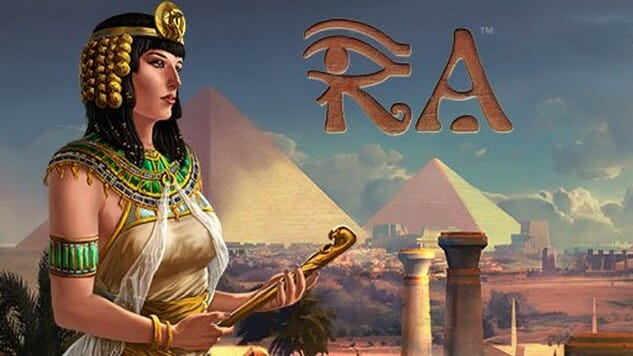Reiner Knizia’s Ra Boardgame

The current surge in interest in better boardgames (German-style, Euro, whatever you want to call them) has led some of the biggest publishers to bring back titles that had fallen out of print or were just in need of a refresh. Two very highly-regarded games are now out in brand-new editions, Reiner Knizia’s Ra and Uwe Rosenberg’s Agricola.
Ra is an Egyptian-themed boardgame from the prolific designer Knizia that uses one of his favorite mechanics—the single-round auction, also found in earlier games like Medici. Players in Ra attempt to collect groups of tiles from a central space through a simple bidding system of tokens (rather than money), trying to accumulate tiles in specific arrangements to satisfy the game’s many ways to gain or lose points. There are three rounds, called “epochs,” after each of which players score for the tiles they have and then are forced to discard some of those tiles. At the end of the game, there’s a final scoring that credits entirely different tiles … which sounds a bit more complicated as I write it than it works when you’re playing.
Ra players start the game with numbered tokens, from two to five depending on the number of players, which they’ll then use to bid on the tiles that appear in the central space. Those tiles come one at a time, at random, from a bag that holds all 180 tiles at the start of the game. Most tiles will somehow help players earn points; a few “disaster” tiles force the player who takes one to discard up to two tiles; and Ra tiles pause the game to auction off all tiles currently on the board. Players may use one of their tokens to bid, with the highest bidder winning, and then exchange that token for the token on the board, which was either the 1-point token from the start of the game or the last token used to win an auction. Each epoch continues until all players have used all their bid tokens or X Ra tiles have appeared.
There are seven classes of tiles, and each scores in a completely different way. The key ones to know:
-

-

-

-

-

-

-

-

-

-

-

-

-

-

-

-

-

-

-

-

-

-

-

-

-

-

-

-

-

-

-

-

-

-

-

-

-

-

-

-









































